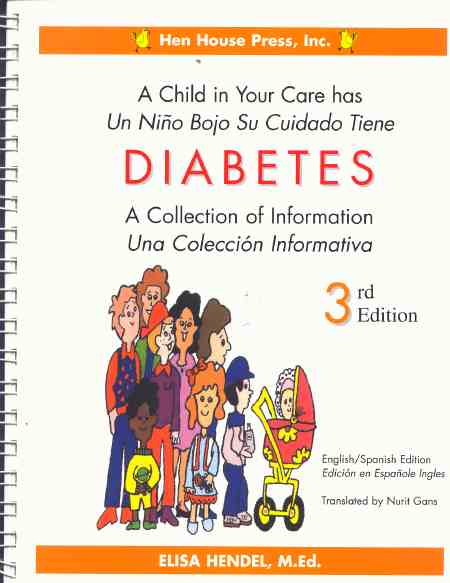My most recent articles are:

Yellow-headed Blackbird
Taken by Sam Toscano in his backyard near Boulder and used with his permission
- The Disintegrator
There aren’t many diabetes products that make people with diabetes happy. But I found one and gave it as a present a couple of weeks ago. It will probably interest anyone who uses insulin. You can read about it on my website at http://www.mendosa.com/disintegrator.htm
- Viva Aviva!
When the biggest meter manufacturer introduces a new meter and a new lancing device at the same time, it’s big news. That’s what this article is.
I wrote about the Aviva meter and the Multiclix lancing device for my “Meter News” column in the August issue of Diabetes Health magazine. The meter will be available this month or next. Until I read the current bestseller, Freakonomics by Steven D. Levitt and Stephen J. Dubner, I thought that Roche’s naming consultants had made up the word Aviva. From Freakonomics I learned that Aviva is one girl’s name that, at least in California, best signifies high-education parents and “may be the one modern Hebrew name that is ready to break out: it’s easy to pronounce, pretty, peppy, and suitably flexible.” My Hebrew-English dictionary indicates that it means springtime. I guess Roche’s introduction is a little late, since this Aviva will come out this summer.
My column about the Aviva meter is also online at http://www.mendosa.com/aviva.htm.
Updates:
- The Pelikan Sun Lancing System
The future of testing came to me this month. Literally. A vice president of Pelikan Technologies in Palo Alto, California, came to Boulder to show me their electronically controlled lancing device that they knew I had been waiting for years to see.I had read and written about it, but to actually use it was incredible. Wherever I tested — on my fingertips, palm, and even my arm (although the FDA has not yet approved it for testing there) — I felt essentially no pain.
The device is already FDA-approved and will be available in the U.S. next year. The article and update are online at my site at http://www.mendosa.com/pelikan.htm
- GI PDF
Thanks to correspondent Grant Spangler, we now have what some people will find is a more useful version of the complete glycemic index. This is a PDF file that you read with Adobe Acrobat. The URL is http://www.mendosa.com/glycemic_index.pdf.
Book and CD Reviews:
I could say that this month there are so many new books and CDs to review that I had to outsource one of them. But that wouldn’t be true. The reason why Gretchen Becker contributed the review below of Conquering Diabetes is because she is the perfect person to write it. Gretchen is probably the best writer about diabetes and is herself conquering the disease, as I wrote about her years ago in my series about people who are Dominating Diabetes.
- Conquering Diabetes

You Can Be In Charge
By Gretchen BeckerBecause I’ve done a lot of literature research into diabetes, I may be hypercritical of new diabetes books. But Conquering Diabetes by diabetologist Anne Peters is a book I really liked.The author, director of the University of Southern California clinical diabetes program, has not only had experience treating hundreds of people with diabetes, but her husband was diagnosed with prediabetes, and she writes, “I suddenly saw firsthand the challenges and frustrations that occur when a health care professional says, ‘Change your lifestyle.’” Luckily, her husband was able to change his, and with that and a TZD (the thiazolidinedione class of drugs that includes Actos and Avandia) has kept diabetes at bay.
She also admits that she herself doesn’t always reach her exercise goals because she’s too busy, tired, or bored. Hence Peters can empathize with her patients, and this empathy and true concern for their problems comes through in her writing.
The book covers the usual bases in a basic diabetes book, and coming from a diabetologist, the information is accurate. But even a patient who is already familiar with the basics might enjoy it because it shows you the problems physicians face as well as those you face yourself, and I think understanding the person on the other side of the desk helps with communication. She has a liberal attitude toward diet, saying “there is no diabetic diet,” and the best one is the one that works for a particular patient. However, she leans toward lower carbs and says she thinks people with diabetes lose weight more easily with fewer carbs.
The bulk of the book is devoted to prediabetes and type 2 diabetes, which makes sense because the bulk of people with diabetes (about 90 percent) have type 2. She also discusses LADA (latent autoimmune diabetes in adults); thin type 2s, gestational diabetes, female troubles, and what used to be called “reactive hypoglycemia” and often precedes type 2. She discusses the GAD (glutamic acid decarboxylase) test but never mentions C peptide (maybe she doesn’t use that test),
Although Peters does have a couple of chapters about type 1, there’s not much detail about insulin usage, as she thinks you need to see a physician or CDE to learn how to use insulin. So this might not be the best stand-alone book for a person with type 1; they’d want to read one of the books on insulin usage as well.
For anyone with type 2 or prediabetes, however, this book is definitely an interesting and instructive read.
Hudson Street Press published Conquering Diabetes for $24.95 in April 2005. The ISBN of this 349-page hardcover book is 159463003.
- Dr. Bernstein’s Secrets

Dr. B’s Secrets
You don’t have to fly to New York any more to get Dr. Richard K. Bernstein’s guidance on how to control your diabetes the way he controls his and has counseled thousands of his patients. Dr. Bernstein recorded a set of five CDs in his office during actual meetings with new patients.
“We know that following Dr. Bernstein’s program can be difficult for some,” writes DiabetesInControl publisher Steve Freed, who produced this CD set. “But when patients simply listen to the CD’s, they seem to get enough information so that they can apply it to their own diabetes management, even if they do not follow his plan exactly.”
Dr. Bernstein has the precision of the engineer that he was before he went to medical school and became one of the most famous endocrinologists. I don’t doubt both that many people have benefited tremendously from following his program and that it is difficult to follow. You can have a normal A1C level in the 4.5 percent range, just like Dr. Bernstein, who has had type 1 diabetes for the past 59 years. But the demands of his program, which he clearly lays out here, are considerable.
Steve Freed sent me the type 2 album, which I review here. A type 1 album is also available. While I don’t follow Dr. Bernstein’s strict recommendations precisely, both his previous books and this set of CDs have influenced me in ways both dramatic and subtle. There’s no question that he knows what he’s talking about and he is always willing to speak frankly.
I learned a lot from listening to these five CDs. Did you know that removing calluses are the major cause of amputations? I didn’t know that neither you or your podiatrist should ever remove them.
Did you know that Dr. Bernstein recommends a Gymnema sylvestre product called “Beta Fast GXR Glucose Balance?” He says that it reduces carbohydrate craving in half the people who use it. He recommends up to six of these 400mg time release pills per day.
To hear his voice on these CDs you can get a fuller picture of this dedicated man and the sense of mission that he has. These CDs aren’t cheap, but your life may be worth it.
The cost is $129.95 for either the type 1 or type 2 album of five CDs, each of which is about one hour long. You can also buy the albums together with one or two of Dr. Bernstein’s books for $147.95 or $159.95 respectively. The URL is
Dr. Richard K. Bernstein’s Diabetes911.net
- Diabetic Travel Tales and Tips

Travel Tales and Tips
This delightful book consists of a lot of experiences told in the form of stores. Interesting stories, well told with light humor.
Marilyn Garcia recounts several personal stories of her own and her friends. Even though she is an attorney, she writes really well with direct, clear, and amusing language. It is upbeat.
The stories are largely about the overseas travel of insulin users and pumpers. They are, of course, those of us with diabetes who have the most trouble when traveling.
I greatly enjoyed the stories. But anyone planning an overseas trip will benefit as much if not more from the tips section that makes up the last third of the book.
“Since I am donating a portion of the sale proceeds to find a cure for diabetes,” Marilyn writes, “more will go towards that goal if people purchase the book by mail order (check only) through diabetictraveltales.com. Donating a portion of sale proceeds guarantees that every sale will yield a donation.”
Mandean Press will publish Diabetic Travel Tales and Tips for $13.95 today, August 1. The ISBN of this 208-page soft cover book is 0976698501.
- The Low GI Diet Cookbook

Eating the Low GI Way
I love to read cookbooks. If I can get even one or two recipes from one, I consider it worth reading. I particularly love low glycemic cookbooks and have collected all of them. But never before have I found a low glycemic cookbook that has so many recipes that excite me so much.
Advanced galleys of The Low GI Diet Cookbook arrived in the mail just a few days before this issue was due. I sat down to read it immediately and was delighted. Some of the recipes are similar to those I already make, and I have to admit that they certainly sound even better. Yesterday I went shopping for the ingredients of several recipes, and I started the day today with the first recipe in the book, a wonderful and simple recipe for “scrambled eggs with smoked salmon.” The rest will follow in the next couple of months.
This Low GI Diet Cookbook is a practical companion to the book I reviewed in January, The Low GI Diet Revolution. It has just 100 recipes, but it’s quality, not quantity that counts in cookbooks. The book has three authors, Dr. Jennie Brand-Miller, Kaye Foster-Powell, and Joanna McMillan-Price, who write that these are the recipes that they love to cook at home.
Marlowe & Company will publish The Low GI Diet Cookbook in November 2005. This soft cover book with 176 oversized pages will list for $19.95. The ISBN 1-56924-359-X.
- A Child in Your Care has Diabetes. A Collection of Information, Third Edition

Caring for A Child
Three years ago in the 39th issue of this newsletter I reviewed the first edition of Eliza Hendel’s A Child in Your Care has Diabetes.
The edition just published is the third. The big change in the 2005 edition is that it is now available in two formats: English or English and Spanish.
Elisa’s daughter Robyn was six when she was diagnosed with type 1 diabetes. When Elisa recovered from the shock of that diagnosis, she diligently collected a huge amount of information on diabetes. Each year she simplified and organized it, distributing it to everyone who is involved in her daughter’s life. Now she is sharing the wealth of her experience with the rest of the world.
What she has created is a concise, easy to follow manual for parents, teachers, caretakers, friends, baby sitters and others who are responsible for a child with diabetes. This small booklet is deceptive. It packs more of value that many books ten times its length.
While the material in this booklet is basic, there is information here that was new to me. I was previously unaware of the importance of section 504 for people with diabetes in schools. The booklet provides detailed guidance about the “504 Accommodations.” Section 504 comes from the Rehabilitation Act of 1973. It provides that “No otherwise qualified individual with a disability in the United States...shall, solely by reason of his or her disability, be excluded from the participation in, be denied the benefits of, or be subjected to discrimination under any program or activity receiving Federal financial assistance or under any program or activity conducted by any Executive agency or by the United States Postal Service.”
Elisa publishes the fruits of her research and experience through Hen House Press Inc., 12 Route 17 North, Suite 212, Paramus, New Jersey 07642; phone (201) 291-9199; fax (201) 291-9177. You can order these books at henhousepress.com or through amazon.com. The 144-page English and Spanish edition, ISBN 0-9718612-2-6, lists for $34.95. The 74-page English edition, ISBN 0-9718612-3-4, lists for $ 27.95.
- Prickly Pear Cactus Medicine

Don’t Touch!
Prickly pear cactus has been an interest of mine ever since I heard that many people in Mexico use it to prevent high blood glucose levels and that it has one of the lowest glycemic indexes, 7. When I was living in California where it is readily available in the markets, I bought it a few times, but really had no idea how to use it.
That’s one of the reasons why I was delighted to receive Ran Knishinsky’s book, Prickly Pear Cactus Medicine: Treatments for Diabetes, Cholesterol, and the Immune System. This book has many recipes for prickly pear, specifically its pads or joints, known as nopal (Spanish: nopales). The fruits, known as Indian fig or cactus pear (Spanish: tuna), and flowers have other (non-diabetic) medicinal uses.
There is a lot more that recipes here too. The core of the book is summaries of the research reports that you could have found yourself by searching MEDLINE through PubMed. Still, it’s handy to have them in one place.
Yet, it doesn’t persuade me to go back to the markets and look for it again. Prickly pear undoubtedly tastes okay, has a great GI, and will probably reduce your blood glucose. But unless it is already a part of your diet and you love the stuff, why bother?
One reason why I won’t bother is something that I learned from this book. There isn’t any way that I know of to tell the difference in the market between Opuntia streptacantha, which has been studied more for its glucose-lowering effect, and Opuntia ficus-indica, which tastes better. Because the latter species is more palatable, my guess is that this is what we would be most likely to find in the markets. I know that where I shop — the Wild Oat Natural Marketplace in Superior, Colorado — that even the produce manager told me he doesn’t know which species of Optunia it is that they sell. He says he would have to contact the distributor to get that information.
This is contrary to what the author, Ran Knishinsky, wrote me. “There is a way to tell the difference,” he wrote. “You will find the opuntia typically labelled on supplements and it will typically define the type of prickly pear inside. On most of the food items, this is also the case.” In my experience, it isn’t.
Besides this problem, I feel about prickly pear the same way that I feel about all the exotic herbs and spices that are purported to have a glucose-lowering effect. They may well work. But they haven’t been rigorously tested like our prescription medicine are and certainly aren’t standardized.
Healing Arts Press in Rochester, Vermont, published this 136-page softcover book in July 2004 for $9.95. You can order it at cactusmedicine.com. The ISBN is 089281149-8.
Research Notes:
- Antioxidants
This item is more about the lack of research, but I found it so interesting that I have mulled it over for months. Back in December 2004 I received an email comment from Dr. Steven Bratman, the man behind the wonderful Natural Pharmacist and one of the few M.D.’s who has studied alternative medicine and has a balanced, objective view. He wrote:Regarding…antioxidant properties…no one seems to have noticed that the blush is off the rose regarding antioxidants. They’ve largely failed; there have been enough failures, anyway, that it no longer makes sense to say of X herb that “it has antioxidant properties, so it must have many health benefits.” There is not a single example of an antioxidant that has been thoroughly tested and proven to have health value by virtue of being an antioxidant. Quite the contrary. The largest double-blind studies in history were performed on the two likeliest suspects, beta carotene and alpha tocopherol, and failed to find benefit. There are numerous preliminary studies finding some benefit with one antioxidant or another, but this only seems to be true so long as the studies remain preliminary; with few exceptions, every time confirming research has been done on a particular antioxidant it has failed to prove effective (by virtue of its antioxidant properties, anyway).That shocked me, in part because I have written here several times about the importance of the oxygen reactivity absorbance capacity (ORAC) of foods, which quantifies their antioxidant capacity. So I wrote the leading ORAC researcher, Ronald L. Prior, Ph.D, of the USDA’s Arkansas Children’s Nutrition Center. His reply was equally interesting:
I do not think we have sufficient research data. I don’t think we can extrapolate from beta carotene and alpha tocopherol to all antioxidants. Also, I do not think that any ‘single’ antioxidant is likely to be effective. We are seeing more and more data suggesting that there is interaction and synergism among different antioxidants. Also, the ultimate mechanism of action of some of the “antioxidant” compounds may not be through antioxidant mechanisms. We have a lot to learn in this area.Dr. Bratman’s rejoinder left me still concerned about the efficacy of antioxidants:
The comment is assuming the conclusion; it’s making the assumption that antioxidants help, and offering in “support” of this claim a statement that antioxidants haven’t been proved ineffective. In fact, they can never be proved ineffective. There are always more, or different antioxidants one could test, or different circumstances in which one could test them. However, antioxidants have failed often enough that the basic hypothesis claiming they are health promoting is on life support. One may still take the hypothesis seriously as a basis for conducting clinical trials, but I would say it is irresponsible at the current state of evidence to recommend antioxidants as treatments by virtue of their being antioxidants.It’s rather like recommending hormone therapy after the WHI [Women’s Health Initiative] study. One can always hypothesize benefit with some different combination of hormones, some other dose of estrogen, or some other form of estrogen. But now that the basic form of hormone replacement therapy has been shown ineffective, the onus is on the proposer to prove benefit with the proposal, not on the disprover to disprove in advance all possible variations.
By the way, I didn’t know if the word is spelled “antioxidant” or “anti-oxidant.” So I turned to the new authority on spelling, Google. This wonderful search engine is the authority because the rules for correct English usage are descriptive — what people actually write — rather than prescriptive — what the “experts” or style guides say we should write. When you search Google for this word, twice as many people nowadays write it without the hyphen.
- The Glycemic Index Newsletter and Blogs
The first issue of this valuable and authoritative newsletter came out in July. The people at the University of Sydney in Australia, led by Dr. Jennie Brand-Miller, who are the leading glycemic index researchers publish this “official news site.” This issue has lots of updated news. What I found most interesting is that we finally have a glycemic index for quinoa, 51. A GI of 55 or less is low.You can read the newsletter on the web or subscribe to its RSS feed in your news aggregator. I use Bloglines to subscribe to this newsletter and a dozen diabetes-related blogs. Bloglines works very well and even has a great choice of notifiers for different platforms. You can find my directory of diabetes blogs in On-line Diabetes Resources Part 2: General Web Sites in a section headed “Diabetes Blogs.”
The URL for the Glycemic Index Newsletter is http://ginews.blogspot.com/.
- This Newsletter
Diabetes Update keeps you up-to-date with new articles, Web pages, and books that I have written about diabetes.I list and link most of these on my at Diabetes Directory and in the site’s menu.
From time to time Diabetes Update may also include links to other Web pages of special interest.
- HTML Format
I send out Diabetes Update e-mail in HTML format, which all Web browsers and most modern e-mail programs can display. HTML has live links to all the sites named in the text so that with a simple click of a mouse you can connect to the site you have just been reading about. - My Guarantee
This newsletter:- Is and will remain free.
- Nor will I ever sell, rent, or trade your e-mail address to anyone.
- I will link sources of information.
- I will disclose any conflict of interest.
- If and when I learn of any errors of fact, I will correct them.
Archives:
I now send out Diabetes Update once a month. Previous issues are online:
- Diabetes Update Number 1: Diabetes Genes of December 10, 2000
- Diabetes Update Number 2: DiabetesWATCH of December 18, 2000
- Diabetes Update Number 3: Starlix of January 3, 2001
- Diabetes Update Number 4: Native Seeds/SEARCH, Tepary Beans of January 17, 2001
- Diabetes Update Number 5: Insulin Makes You Fat of January 31, 2001
- Diabetes Update Number 6: Available and Unavailable Carbohydrates of February 15, 2001
- Diabetes Update Number 7: Dates of March 1, 2001
- Diabetes Update Number 8: Quackwatch of March 15, 2001
- Diabetes Update Number 9: The Cost of Insulin of March 30, 2001
- Diabetes Update Number 10: Sof-Tact Meter of April 2, 2001
- Diabetes Update Number 11: iControlDiabetes of April 16, 2001
- Diabetes Update Number 12: Cinnamon, Tagatose of May 2, 2001
- Diabetes Update Number 13: Glycemic Index of May 15, 2001
- Diabetes Update Number 14: Eat Your Carrots! of May 31, 2001
- Diabetes Update Number 15: Glycemic Load of June 21, 2001
- Diabetes Update Number 16: Homocysteine of July 2, 2001
- Diabetes Update Number 17: Chana Dal Tips of July 15, 2001
- Diabetes Update Number 18: Lag Time in AlternativeLand of August 2, 2001
- Diabetes Update Number 19: Fiber of August 15, 2001
- Diabetes Update Number 20: How Diabetes Works of August 30, 2001
- Diabetes Update Number 21: Insulin Resistance of September 14, 2001
- Diabetes Update Number 22: Trans Fats, Honey, CU of October 1, 2001
- Diabetes Update Number 23: Pedometer Power of October 15, 2001
- Diabetes Update Number 24: Is Glycerin a Carbohydrate? of October 31, 2001
- Diabetes Update Number 25: Kill the Meter to Save It of November 15, 2001
- Diabetes Update Number 26: Protein, Fat, and the GI of December 1, 2001
- Diabetes Update Number 27: Insulin Index of December 14, 2001
- Diabetes Update Number 28: Fructose of January 4, 2002
- Diabetes Update Number 29: Aspirin of January 14, 2002
- Diabetes Update Number 30: Stevia of January 31, 2002
- Diabetes Update Number 31: Gretchen Becker’s Book of February 19, 2002
- Diabetes Update Number 32: The UKPDS of March 4, 2002
- Diabetes Update Number 33: Financial Aid of March 18, 2002
- Diabetes Update Number 34: Pre-Diabetes of April 1, 2002
- Diabetes Update Number 35: More Glycemic Indexes of April 15, 2002
- Diabetes Update Number 36: Gila Monsters of April 30, 2002
- Diabetes Update Number 37: Is INGAP a Cure? of May 15, 2002
- Diabetes Update Number 38: Native American Diabetes of June 3, 2002
- Diabetes Update Number 39: FDA Diabetes of June 19, 2002
- Diabetes Update Number 40: Diabetes Support Groups of July 1, 2002
- Diabetes Update Number 41: New GI and GL Table of July 15, 2002
- Diabetes Update Number 42: Diabetes Sight of August 1, 2002
- Diabetes Update Number 43: DrugDigest of August 18, 2002
- Diabetes Update Number 44: Hanuman Garden of September 3, 2002
- Diabetes Update Number 45: Guidelines of September 16, 2002
- Diabetes Update Number 46: Trans Fat of October 4, 2002
- Diabetes Update Number 47: Nutrition.Gov of October 16, 2002
- Diabetes Update Number 48: Our Hearts of October 31, 2002
- Diabetes Update Number 49: Our Kidneys of November 15, 2002
- Diabetes Update Number 50: A1C<7 of December 2, 2002
- Diabetes Update Number 51: Diabetes Searches with Google of December 16, 2002
- Diabetes Update Number 52: e-Patients of January 2, 2003
- Diabetes Update Number 53: Email News of January 16, 2003
- Diabetes Update Number 54: Third Generation Meters of January 31, 2003
- Diabetes Update Number 55: Hypoglycemic Supplies of February 14, 2003
- Diabetes Update Number 56: Food Police of March 1, 2003
- Diabetes Update Number 57: Vitamins of April 1, 2003
- Diabetes Update Number 58: Lancets of May 1, 2003
- Diabetes Update Number 59: Accurate Meters of June 1, 2003
- Diabetes Update Number 60: Chromium of July 1, 2003
- Diabetes Update Number 61: Traveling of August 1, 2003
- Diabetes Update Number 62: My Book of September 1, 2003
- Diabetes Update Number 63: Hot Tubs of October 1, 2003
- Diabetes Update Number 64: Home A1C Testing of November 1, 2003
- Diabetes Update Number 65: Detemir of December 1, 2003
- Diabetes Update Number 66: Erectile Dysfunction of January 1, 2004
- Diabetes Update Number 67: Acidic Foods of February 1, 2004
- Diabetes Update Number 68: Net Carbs of March 1, 2004
- Diabetes Update Number 69: Glycemic Index of April 1, 2004
- Diabetes Update Number 70: Dreamfields Pasta of May 1, 2004
- Diabetes Update Number 71: Cholesterol of June 1, 2004
- Diabetes Update Number 72: Meter News of July 1, 2004
- Diabetes Update Number 73: Pill Splitting of August 1, 2004
- Diabetes Update Number 74: GlucoMON of September 1, 2004
- Diabetes Update Number 75: Coding of October 1, 2004
- Diabetes Update Number 76: Sleep Apnea of November 1, 2004
- Diabetes Update Number 77: Keynote Address of December 1, 2004
- Diabetes Update Number 78: Mangosteen of January 1, 2005
- Diabetes Update Number 79: Noninvasive Dream of February 1, 2005
- Diabetes Update Number 80: Pelikan Sun of March 1, 2005
- Diabetes Update Number 81: Medtronic Monitors of April 1, 2005
- Diabetes Update Number 82: ExtendBars of May 1, 2005
- Diabetes Update Number 83: GlycoMark of June 1, 2005
- Diabetes Update Number 84: My British Book of July 1, 2005



